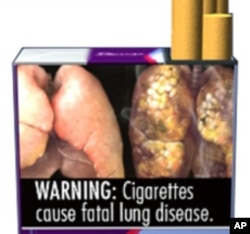The U.S. Food and Drug Administration (FDA) is getting ready to update its warning labels on cigarette packs for the first time since the 1980's.
The new labels come with graphic images of the health hazards posed by smoking and, says Danny McGoldrick of the Campaign for Tobacco Free Kids, a Washington-based anti-smoking group, are much larger than current labels.
The FDA is now soliciting comments from the public on its website for the new labels. But it took 10 years of scientific research and non-stop pressure by groups like McGoldrick's to get the United States to join the 45 other countries that mandate similar warnings.
McGoldrick told VOA's Paul Westpheling that the new labels won't appear on cigarette packs until late 2012 and are part of a long battle that ended with the signing of Tobacco Control Act by President Barack Obama in 2009.
Why is this such a big development? There have been warning labels on cigarettes for decades.
"One reason it's so important is not only does it command these new and graphic warning labels, but it gives the Food and Drug Administration [FDA] the flexible authority to revise those warning labels moving forward. As the science develops in terms of the damage caused by tobacco, if there are new things to educate smokers and potential smokers about, or if we learn how better to communicate with smokers, the FDA can do that through the rule-making process rather than through an act of [the U.S.] Congress."
What evidence do you have that these warning labels will really reduce smoking?
"One of the reasons we need these warning labels is because our progress has essentially stalled in reducing smoking. This has been a major public health victory, but we still have over 20 percent of Americans smoking and that figure hasn't really changed in about the last five years. We're hopeful that the enhanced warning labels, as part of a comprehensive plan that will include media campaigns, community-based programs, as well as policies like increased tobacco taxes that we know reduces smoking. If we do all these things, we'll begin making progress again."
What has been the reaction from tobacco companies?
"Several companies have sued over this provision of the FDA law. That remains in the courts. The District Court [the lowest level court in the U.S. federal court system] upheld the requirement for the graphic warning label. When the tobacco industry knows that something reduces smoking, they tend to fight it. They fight us on taxes. They fight us on smoke-free laws. Now they are suing on the warning labels. They are in the business of making money. Those of us in the business of public health are in the business of fewer people smoking and dying and suffering from tobacco related disease."














